Do you have ever seen any plant or animal decaying/decomposing at the soil surface?
Have a look at the picture below:
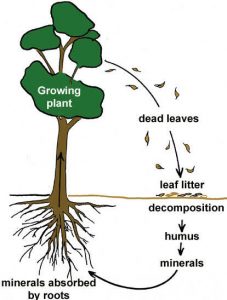
In the picture, leaves from plants are falling down and decomposed at the soil. These leaves are called organic matter.
Best safe and secure cloud storage with password protection
Get Envato Elements, Prime Video, Hotstar and Netflix For Free
Best Money Earning Website 100$ Day
#1 Top ranking article submission website
Organic matter includes any plant or animal material that returns to the soil and goes through the decomposition process.
According to Russell, “Soil organic matter consists of a whole series of products which ranges from undecayed plant and animal tissues through ephemeral products of decomposition to fairly stable amorphous brown to black material bearing no trace of anatomical structure of the material from which it was derived and it is the latter material that is normally defined as the soil humus.”
Sources of organic matter
There are two types of sources of soil organic matter:
a) Primary /Main sources
Undecomposed, partially decomposed or completely decomposed plant tissues are the primary or main sources of soil organic matter.
b) Secondary sources
Animal tissues and micro-organisms are the secondary sources of organic matter in soil.
Humus
(Another name: Organic colloid)
Humus is the final position of decomposed material. Decomposition occurs by micro-organisms present in the soil. After decomposition, decomposed matter totally loss its structure that’s called humus.
According to Buckman and Brady, “Humus is a complex rather resistant mixture of brown or dark brown, amorphous and colloidal substances modified from the original tissues or synthesized by the various soil organisms.”
- Amorphous: Having no clear structure.
Soil Organic Matter (SOM)
There are many carbon-based compounds in nature. Organic matter pertains to any of the carbon-based compounds that is present in large number or amount in nature.
An organic compound must contain carbon and hydrogen. The four major categories of organic compounds that are present in all living things are carbohydrates, lipids, proteins and nucleic acid. So, living things are described as organic since they are composed of organic compounds e.g. carbohydrates, lipids, proteins and nucleic acids.
Sources
There are two types of sources of soil organic matter:
a) Primary /Main sources:
Undecomposed, partially decomposed or completely decomposed plant tissues are the primary or main sources of soil organic matter.
b) Secondary sources:
Animal tissues and micro-organisms are the secondary sources of organic matter in soil.
Composition
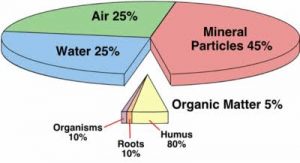
Functions of organic matters
Organic matters (OM) serves many purposes in the soil. In general, they are classified into 3 categories.
- Physical functions
- Chemical functions
- Biological functions
Physical functions
- Coarse (big in size) organic matters reduces surface runoff and erosion and avails more water for plants.
- OM helps in forming and stabilizing soil aggregates. These aggreagates favours aeration and permeability in the soil.
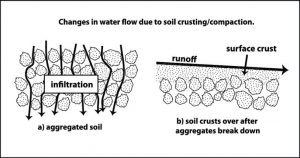
Source here - Decayed matters create large pores in the soil that helps in root respiration and growth.
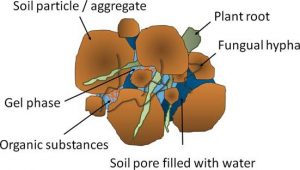
Source - Increases water holding capacity of soil.
- Surface mulches ( substance placed on the soil surface) lower soil temperature in the summer and keep the soil warmer in winter.
- Evaporation losses of water are reduced by organic mulches. These mulches also provide nutrients to the soil when decomposed.
Chemical functions
- During decomposition of organic matters, organic acids and CO2 are produced. These helps to dissolve minerals in soil water and increases their availability to plants.
- Organic acids released from decomposing organic matters help to reduce alkalinity un soils.
- OM helps to buffer soil against rapid chemical changes in pH due to the addition of lime and fertilisers.
- Humus provides a storehouse for exchangeable and available cations k+, Mg2+ , Ca2+ as well as ammonium (NH4+ ) fertilisers.
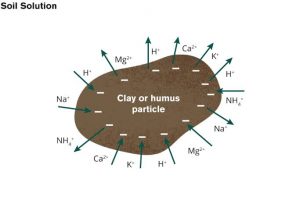
Ion exchange - Fresh organic materials have a special function in making soil phosphorus more readily available in acid soils.
Biological functions
- Organic matter serves as a reservoirs of chemical elements essential for plant growth such as k, N2, Na etc.
- Serves as a source of energy for the growth of soil micro-organisms.
- Fresh matters supply food for soil life such as earthworm, ants and rodents.
References :
1. https://www.uwa.edu.au/projects/role-of-soil-microorganisms
2. Soils: their chemistry and fertility in tropical Asia- Tamhane RV, DP Motitamani, YP Bali and RL Donahue.
3. Soil fertility and fertilisers- Tisdale SL, WL Nelson, JD Beaten, JL Havlin.
4. Researchgate.
Written by
Tarek Siddiki Taki
 Plantlet The Blogging Platform of Department of Botany, University of Dhaka
Plantlet The Blogging Platform of Department of Botany, University of Dhaka
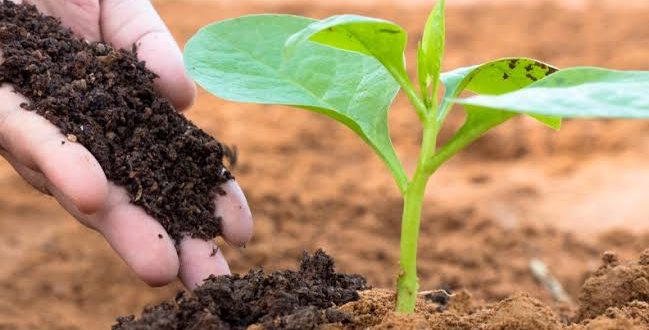





Your article gave me a lot of inspiration, I hope you can explain your point of view in more detail, because I have some doubts, thank you.
Thanks for sharing. I read many of your blog posts, cool, your blog is very good.